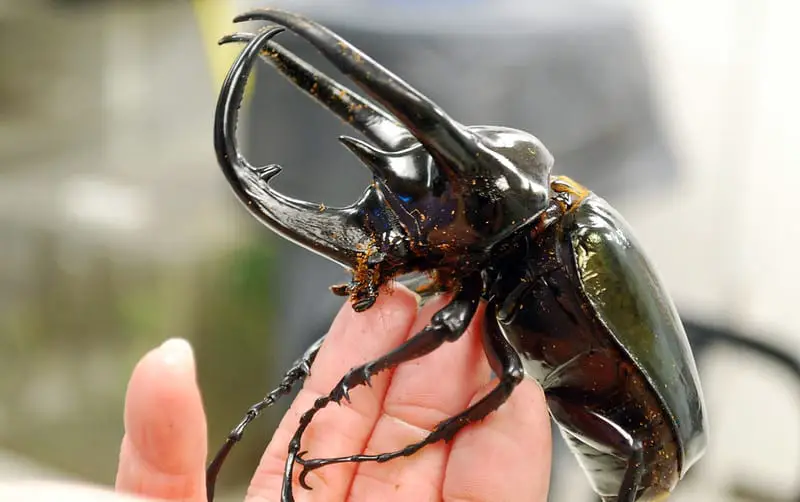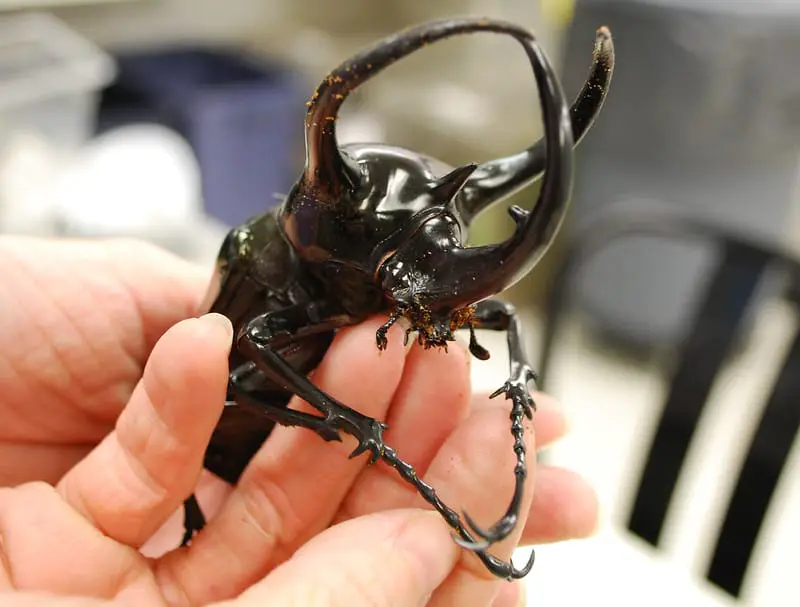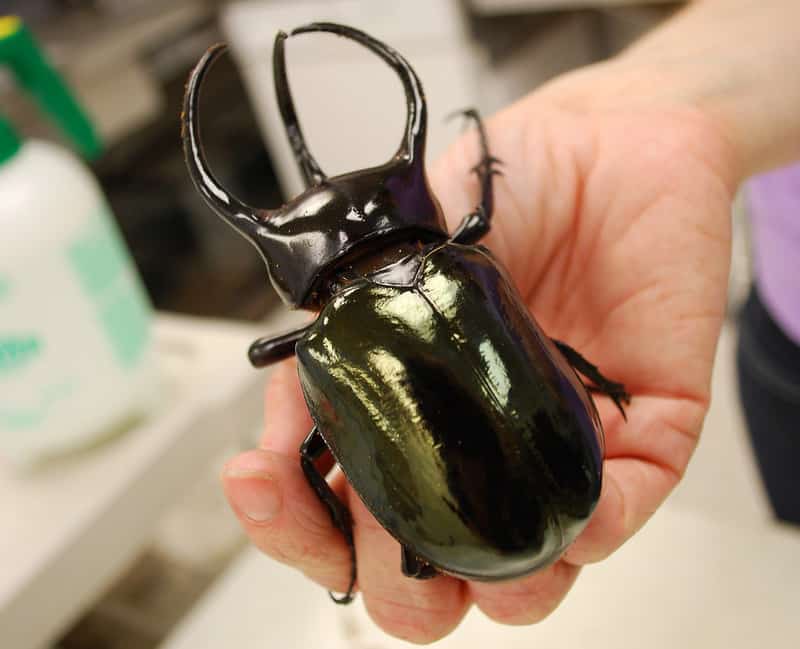The Atlas Beetle is one of the longest and largest beetles in Asia. It’s popular as an exotic pet for its beautiful look, incredible power, and peaceful demeanor.
It’s also straightforward to care for them, so it’s a low-maintenance pet that you can keep easily if you’re interested in bug keeping.
If you’re considering getting one of these amazing insects, we’ve gathered all the information you need to know to properly care for them!

Atlas Beetle Care Sheet
| Name of species | Chalcosoma atlas |
| Family | Scarabaeidae |
| Common name | Atlas Beetle |
| Category | Beetle |
| Type | Rhinoceros Beetle |
| Native location | Southeast Asia |
| Size | 5 inches |
| Weight | 3.5 ounces |
| Diet | Decaying compost and wood, fruit, and leaves |
| Lifespan | 3+ years |
| Experience level | Beginner |
Atlas Beetle overview

The Chalcosoma atlas is commonly known as the Atlas Beetle. It’s part of a larger group of insects called the rhinoceros beetles, which all share horns they use to defend themselves and fight over territory. It’s native to Southeast Asia, where you’ll usually find it feeding on tree bark. The Atlas Beetle is peaceful but territorial, so it’s better to avoid keeping two together in the same space.
Appearance
Atlas beetles are large insects with dark and shiny exoskeletons. They have round bodies and long thorny legs to hold onto vertical surfaces despite their size. They’re usually black, but they can also display greenish tones to camouflage them in their natural habitat.
The AB has significant sexual dimorphism, which means that males are very easily distinguished from females. Male specimens are larger, with a smoother exoskeleton and three horns they use to fight over territory. Some males of this species display shorter horns, but most male ABs have long curved horns fit for defense.
Price
Atlas Beetles are considered a pest for agriculture. Therefore, some countries may require you to get a permit before you buy one.
Grubs will cost around $15 to $20 each. Adults of any sex will usually cost about $50 to $70, but males have a tendency to be more expensive due to their size and appearance.
Behavior and Temperament
The Atlas Beetle is a very large and territorial insect. Males use their horns to fight over territory and the chance to mate with available females, so it’s best not to keep two males in the same enclosure. Their propensity to be left alone goes back to their time as larvae when they’ll fight and sometimes kill each other over available food.
Besides all of this, most owners claim them to be very peaceful insects, and they’re easy to handle as long as they’re not startled by sudden movements.
You should only be careful about holding larvae since they’re aggressive and will bite under the slightest provocation.
However, your biggest worry with adult specimens should be not to lift them if they’re holding too firmly at something (removing them may break their legs).
Caring for an Atlas Beetle

Temperature and Humidity
The Atlas Beetle needs a well-ventilated enclosure to be comfortable and healthy. They live in a tropical rainforest, where temperatures and humidity levels are very high.
You should keep your AB in humidity levels of 75%-90% and temperatures ranging from 70°F to 80°F, as these conditions are very similar to the ones in their natural habitat.
Substrate
The substrate needs for an Atlas Beetle change with its development. The smartest choice for an AB larva is flake soil, which works both as food and substrate.
Adult ABs are comfortable with a mixture of peat moss and organic soil as a substrate.
These beetles don’t burrow, so two inches of substrate will be more than enough for them.
Tank
An Atlas Beetle is a large insect full of energy; therefore, it’s most comfortable inside large enclosures. Larvae can be kept in one-gallon enclosures, but adults should get around seven gallons to make sure they’re comfortable.
A safety lock in the enclosure’s lid will be a welcome addition to keep your AB from escaping. While male beetles must be housed singularly, females can be held in the same place, in which case you should increase the enclosure size by 50% per beetle.
Decorations such as small rocks will keep your beetle busy, and yourself entertained.
These insects are known for lifting and moving around whatever they find in their path, so you’ll often get the chance to see them redecorating their enclosure.
Watering
Atlas Beetles are used to moist environments, but they don’t like wet soils. Spray their substrate with water until it’s moist, but make sure not to let it get muddy; a good rule of thumb is to check if you’re able to squeeze the substrate between your fingers without it dripping water, but the soil is still holding itself together.
As for additional hydration, the AB gets enough water content from its food, so placing a water dish inside the tank isn’t necessary, but you can do it to provide them with some extra moisture.
Diet of an Atlas Beetle
Food is the most important precaution you’ll need to take when caring for your Atlas Beetle. Larvae can be fed with flake soil, and if you make it their substrate, it won’t be difficult for you to feed the AB larvae.
Just make sure to clean the substrate by removing the upper layers once most of it is covered by droppings.
Adult beetles can eat beetle jelly and sweet diced fruit. Always choose fruit that’s soft and low on water, such as mangoes and bananas.
Fruits that are uneaten and leftover after one day should be removed to avoid mold growth.
However, beetle jelly is the best choice since it doesn’t require to be removed, and it’s also known for having the best nutritional value for an AB.
Fun Facts about the Atlas Beetle
- The Chalcosoma atlas gets both its scientific name and its common name from the Greek figure Atlas. In Greek Mythology, Atlas was condemned to carry the whole weight of the sky over its shoulders. This is where a link can be found between the character and the beetle since the AB is known for being able to lift several times its own weight.
- Atlas Beetles are way too heavy to fly adequately, making a ground takeoff an almost impossible task. They can, however, fly short distances if they takeoff from high places in trees. Because of this incapacity to travel, they have been unable to migrate too far from its natural habitat.
- The most important predator of the Atlas Beetle in the wild is the Giant Scoliid Wasp. A wasp that parasites the beetle by depositing its eggs inside an AB larva. Once the egg hatches, the resulting larva consumes the (paralyzed) prey from the inside.
- You can have multiple female ABs living in the same tank, but you shouldn’t communally house male specimens unless you want them to breed. Also, males are known for sometimes attacking and killing females, so you should take extra precautions to protect them.
Final words: Is the Atlas Beetle Right for you?
Whether you’re looking to start a small colony or want an exciting and beautiful pet to handle in front of your friends, the Atlas Beetle is a great choice. They’re quite large, imposing to look at (especially the males), and quite friendly towards humans.
Whether you’re a beginner in the bug-keeping hobby or have raised many insects from larva to adult, the Atlas Beetle has something for everyone!
- How Long Do American Eskimo Dogs Live? Important Factors and Care Tips - September 29, 2023
- Do American Bulldogs Need Grooming? Essential Tips and Care Guidelines - September 29, 2023
- Do Bengal Cats Enjoy Playing? Essential Tips for Keeping Them Active - September 29, 2023